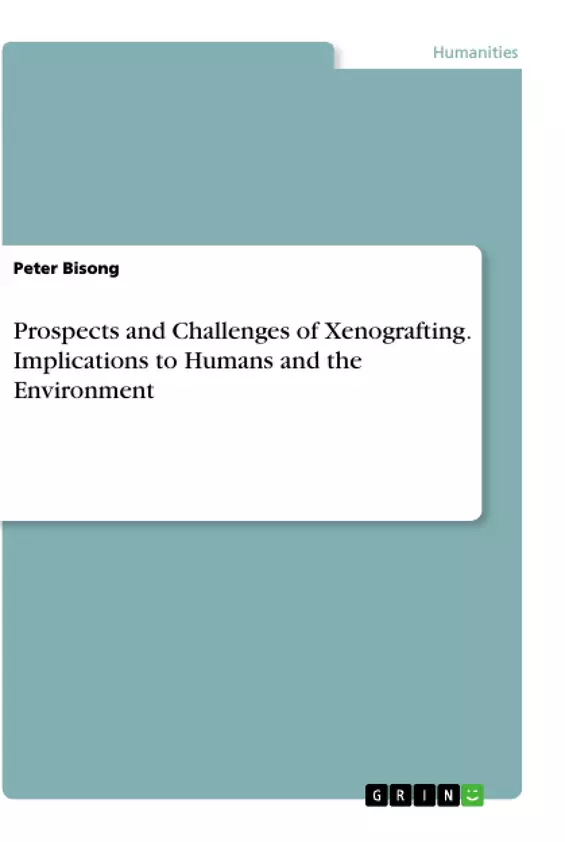This work gives support to the already done research on the ethical implication of xenografting and also challenges the committee of philosophers and scientists to join in the cost-benefit analysis of xenotransplantation. It is not good to endanger our future, that of the animals and other beings just for temporary gains that xenotransplantation holds for us. The end should not be made to justify the means – both are important. The means and the end must be held in complementary relationship as Asouzu would advise – the means and the end forms one complementary horizon and none is absolute. The main aim of this book is to conduct a philosophical appraisal of the implications of xenotransplantation to humans and the environment at large.
At present xenotransplantation could arguably be said not to be a risk, which would imply that this research is not justified. However, it is good to note, that research efforts are seriously ongoing, implying that in the nearest future, there would be a breakthrough in xenotransplantation and it would become a clinical success. Better immunosuppressive drugs are being sought for and research is also making significant progress in genetic engineering of pigs (the most favoured animals for xenotransplantation), so as their organs would not suffer hyperacute rejection when used in humans. The possibility that researches would yield result necessitates this research. I believe that it is better to nip a problem at the bud than to combat it when it is already full blown. Now that xenotransplantation is not yet fully developed and its catastrophic effects are not yet evident, it is better to tackle it, so as to save mankind and the world at large from imminent danger. Prevention is always better than cure.
Inhaltsverzeichnis (Table of Contents)
- Introduction
- History, types and source animals for xenografting
- Advantages and disadvantages of xenografting
- Motivation for xenografting
- Barriers to clinical success of xenotransplantation
- Medical challenge posed by xenografting
- Psychological effects of Xenografting
- Religious challenges of Xenografting
- Epistemological challenges of Xenografting
- Legal Dilemma posed by Xenografting
- Ethical challenges posed by Xenografting
- Xenografting and issues of animal rights
- Concluding remarks
Zielsetzung und Themenschwerpunkte (Objectives and Key Themes)
This book aims to provide a comprehensive analysis of xenografting, exploring its history, advantages, disadvantages, challenges, and ethical implications. The primary focus is on the transfer of organs and tissues from animals to humans, highlighting the potential benefits while acknowledging the significant obstacles and concerns associated with this procedure.
- History and Development of Xenografting
- Scientific and Medical Challenges of Xenografting
- Ethical Considerations and Animal Rights
- Religious and Psychological Perspectives on Xenografting
- Legal and Epistemological Dilemmas
Zusammenfassung der Kapitel (Chapter Summaries)
- Introduction: This chapter defines xenografting and provides a brief historical overview, emphasizing the renewed interest in this field due to advancements in immunosuppressive drugs, transgenic technologies, and the growing shortage of human organs for transplantation. It outlines the main motivations for pursuing xenografting, including the potential to address organ shortages and treat various health conditions.
- History, types and source animals for xenografting: This chapter delves deeper into the historical development of xenografting, exploring different types of xenotransplantation and the various animal sources used. It discusses early attempts and setbacks, emphasizing the challenges associated with immune rejection and the risk of transmitting novel infectious diseases.
- Advantages and disadvantages of xenografting: This chapter examines the potential benefits of xenografting, such as addressing the shortage of human organs and providing alternative treatment options for various diseases. It also explores the drawbacks, including the risk of immune rejection, the potential transmission of infectious diseases, and ethical concerns related to animal welfare.
- Motivation for xenografting: This chapter examines the driving forces behind the renewed interest in xenografting. It highlights the role of technological advancements, such as improved immunosuppressive drugs and transgenic technologies, in overcoming previous obstacles. It also explores the pressing need for alternative organ sources to address the growing demand for transplantation.
- Barriers to clinical success of xenotransplantation: This chapter focuses on the major challenges that hinder the clinical application of xenotransplantation. It examines the medical, psychological, religious, epistemological, legal, and ethical aspects of this procedure, highlighting the complexities and controversies surrounding its implementation.
- Xenografting and issues of animal rights: This chapter examines the ethical implications of using animals as organ donors, considering the welfare and rights of the animals involved. It explores the arguments for and against using animals for transplantation, addressing concerns about animal exploitation and the potential for harm.
Schlüsselwörter (Keywords)
This work focuses on the field of xenotransplantation, examining its history, current challenges, and ethical implications. Key terms include xenografting, xenotransplantation, organ transplantation, animal models, immunosuppression, transgenic technologies, infectious diseases, ethical considerations, animal rights, religious perspectives, legal dilemmas, and epistemological challenges. This comprehensive analysis of xenotransplantation explores the scientific, medical, and ethical complexities associated with this emerging field.
- Citar trabajo
- Dr. Peter Bisong (Autor), 2019, Prospects and Challenges of Xenografting. Implications to Humans and the Environment, Múnich, GRIN Verlag, https://www.grin.com/document/508576



